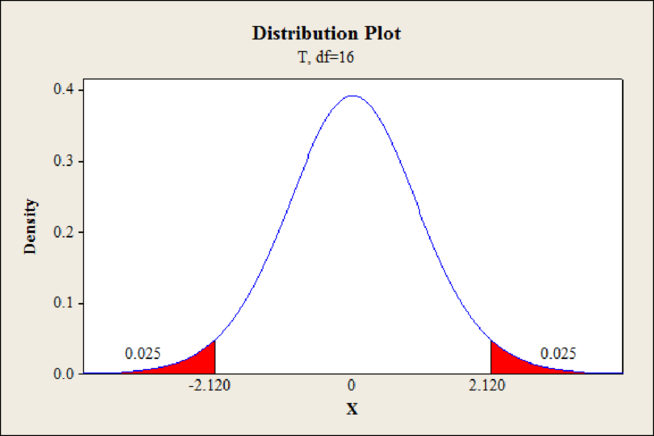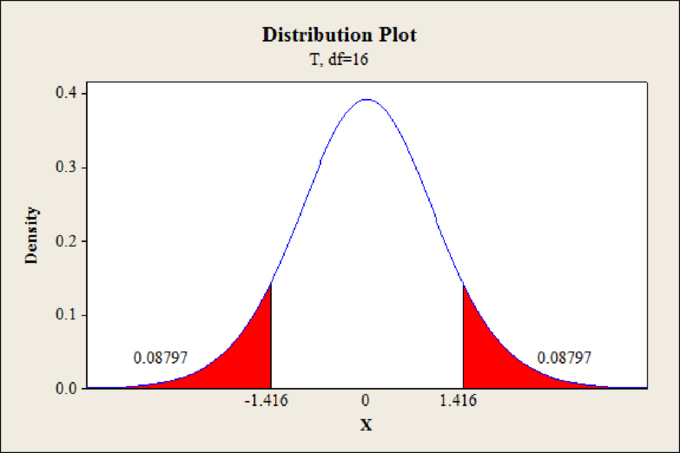
a.
Determine the decision rule.
a.
Explanation of Solution
Calculation:
Degrees of freedom:
The degrees of freedom is as follows:
Step-by-step procedure to obtain the critical value using MINITAB software:
- 1. Choose Graph > Probability Distribution Plot choose View Probability > OK.
- 2. From Distribution, choose ‘t’ distribution.
- 3. In Degrees of freedom, enter 16.
- 4. Click the Shaded Area tab.
- 5. Choose the P Value and Two Tail for the region of the curve to shade.
- 6. Enter the probability value as 0.05.
- 7. Click OK.
Output obtained using MINITAB software is given below:

From the MINITAB output, the critical value is
The decision rule is,
If
If
b.
Find the value of the pooled estimate of the population variance.
b.
Answer to Problem 7E
The pooled estimate of the population variance is 19.9375.
Explanation of Solution
Calculation:
Pooled estimate:
The pooled estimate of the population variance is as follows:
Substitute
Thus, the pooled estimate of the population variance is 19.9375.
c.
Find the value of test statistic.
c.
Answer to Problem 7E
The value of the test statistic is –1.416.
Explanation of Solution
Test statistic:
The test statistic for the hypothesis test of
Substitute
Thus, the test statistic is –1.416.
d.
Determine the decision regarding
d.
Answer to Problem 7E
The decision is fail to reject the null hypothesis.
Explanation of Solution
Decision:
The critical value is –2.120 and the value of test statistic is –1.416.
The value of the test statistic is greater than the critical value.
That is,
From the decision rule, fail to reject the null hypothesis.
e.
Find the p-value.
e.
Answer to Problem 7E
The p-value is 0.175.
Explanation of Solution
Step-by-step procedure to obtain the p-value using MINITAB software:
- 1. Choose Graph > Probability Distribution Plot choose View Probability > OK.
- 2. From Distribution, choose ‘t’ distribution.
- 3. In Degrees of freedom, enter 16.
- 4. Click the Shaded Area tab.
- 5. Choose X Value and Two Tail for the region of the curve to shade.
- 6. Enter the X value as –1.416.
- 7. Click OK.
Output obtained using MINITAB software is given below:

From the MINITAB output, the p-value for one side is 0.08797.
Thus, the p-value is 0.175.
Want to see more full solutions like this?
Chapter 11 Solutions
STATISTICAL TECHNIQUES FOR BUSINESS AND
- Show all workarrow_forwardplease find the answers for the yellows boxes using the information and the picture belowarrow_forwardA marketing agency wants to determine whether different advertising platforms generate significantly different levels of customer engagement. The agency measures the average number of daily clicks on ads for three platforms: Social Media, Search Engines, and Email Campaigns. The agency collects data on daily clicks for each platform over a 10-day period and wants to test whether there is a statistically significant difference in the mean number of daily clicks among these platforms. Conduct ANOVA test. You can provide your answer by inserting a text box and the answer must include: also please provide a step by on getting the answers in excel Null hypothesis, Alternative hypothesis, Show answer (output table/summary table), and Conclusion based on the P value.arrow_forward
- A company found that the daily sales revenue of its flagship product follows a normal distribution with a mean of $4500 and a standard deviation of $450. The company defines a "high-sales day" that is, any day with sales exceeding $4800. please provide a step by step on how to get the answers Q: What percentage of days can the company expect to have "high-sales days" or sales greater than $4800? Q: What is the sales revenue threshold for the bottom 10% of days? (please note that 10% refers to the probability/area under bell curve towards the lower tail of bell curve) Provide answers in the yellow cellsarrow_forwardBusiness Discussarrow_forwardThe following data represent total ventilation measured in liters of air per minute per square meter of body area for two independent (and randomly chosen) samples. Analyze these data using the appropriate non-parametric hypothesis testarrow_forward
 Glencoe Algebra 1, Student Edition, 9780079039897...AlgebraISBN:9780079039897Author:CarterPublisher:McGraw Hill
Glencoe Algebra 1, Student Edition, 9780079039897...AlgebraISBN:9780079039897Author:CarterPublisher:McGraw Hill College Algebra (MindTap Course List)AlgebraISBN:9781305652231Author:R. David Gustafson, Jeff HughesPublisher:Cengage Learning
College Algebra (MindTap Course List)AlgebraISBN:9781305652231Author:R. David Gustafson, Jeff HughesPublisher:Cengage Learning

